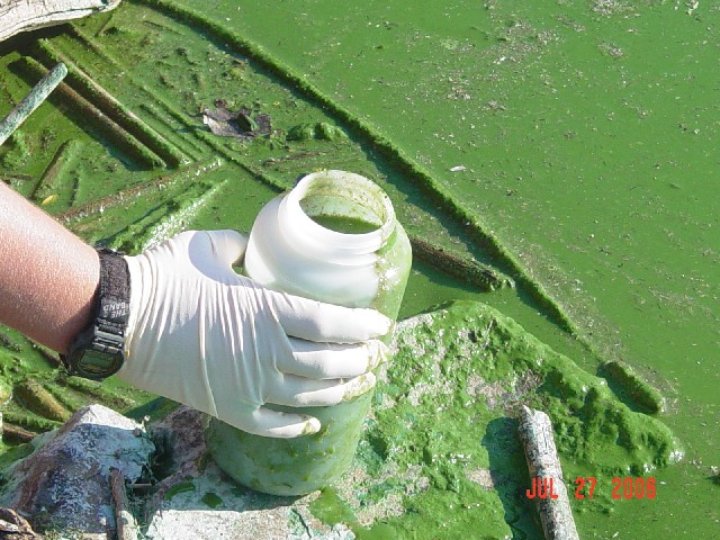
Photo: Yurok Tribe.
From the Yurok Tribe:
The extremely elevated levels of a liver-damaging toxin in the Lower Klamath River is a symptom of a pervasive problem that has far-reaching implications.
“The Klamath River is extremely sick,” said Thomas P. O’Rourke Sr., Chairman of the Yurok Tribe. “Algae are a clear indicator of poor water quality, which negatively affects the salmon population and the ecosystem as a whole. It’s frustrating that even with this year’s above-average rainfall and snowpack, the river conditions are still compromised.”
The Yurok Tribe Environmental Program, during its weekly water quality tests on September 12 and 13, detected record-breaking levels of microcystin, a contaminant emitted by a toxic algal species called Microcystis aeruginosa. The test results contained 10 to 30 times more of the toxin than common health standards deem safe and were the highest since testing began in 2006.
This year, high rates of microcystin first showed up in late August, which prompted Tribal and public health officials to warn residents against contacting a 200-mile stretch of the river below the lower four Klamath dams. In addition to causing injury to the livers of humans and other mammals, exposure to the toxin is also harmful to the eyes, skin and throat.
“Tribal fishers cannot avoid contact with the river and regularly suffer from severe skin rashes on their arms as a result of reaching into the water to bring fish on their boats. For millennia, our ceremonial practitioners have entered the river in the late summer, but have recently had to forego this sacred ritual to avoid getting sick,” Chairman O’Rourke said. “It is unacceptable that this ultimately resolvable problem has been allowed to persist for so long.”
Each summer, massive microcystis blooms form in the reservoirs behind the Copco and Iron Gate dams, which produce the ideal conditions for this particular algal species to rapidly reproduce. Located in an area with an arid climate, the shallow reservoirs are filled with warm water and abundant agricultural waste from a sprawling network of farms near the Klamath’s headwaters. The combination of heat and nutrients enable the algae to multiply. When dropping temperatures at the end of summer kill the photosynthetic microorganism it broadcasts the toxin down river.
The four dams on the Klamath River are on a trajectory for removal in 2020, pursuant to the amended Klamath Hydroelectric Settlement Agreement, which was signed in April 2016 by the owner of the dams, PacifiCorp, and California, Oregon, Yurok and Karuk Tribes, along with several other conservation groups and stakeholders. The petition to remove the four dams is currently going through the permitting processes of the Federal Energy Regulatory Commission and the Water Boards of the states of California and Oregon.
“It is a known fact that the Klamath dams are an incubator for the toxic algae. Removing the four dams will substantially reduce the quantity of the toxin present in the river, to a point where our people can once again practice our traditional ceremonies without being subject to toxic water quality,” Chairman O’Rourke said. “The water quality improvements that will come from the taking down the fish-blocking dams will also significantly improve struggling salmon runs on the Klamath.”
The 15,000 square-mile Klamath Basin occupies a rural, sparsely populated landscape. The river, once the producer of an estimated 1 million salmon per year, predominantly flows through a forest environment that is far from any metropolitan centers, and for this reason fisheries researchers believe it is the most restorable, large watershed in the West.
This year, the primary Klamath chinook run was predicted to be the worst in history. While the final numbers will not be available until later this year, very few fish have been seen making the spawning migration.
“As Yurok people, we have an obligation to speak up for the salmon and the health of our river. If the river is not responsibly managed, there will be no fish for future generations. The Yurok Tribe asks all interested individuals to join our battle to begin to heal the Klamath.” concluded Chairman O’Rourke.
CLICK TO MANAGE